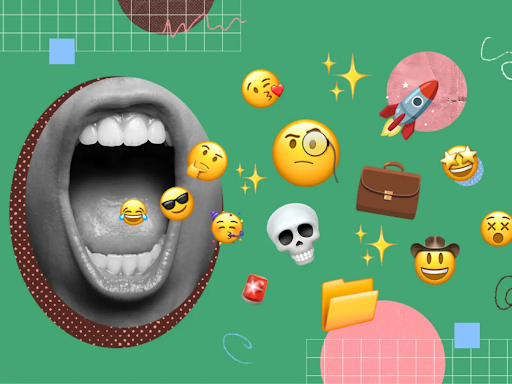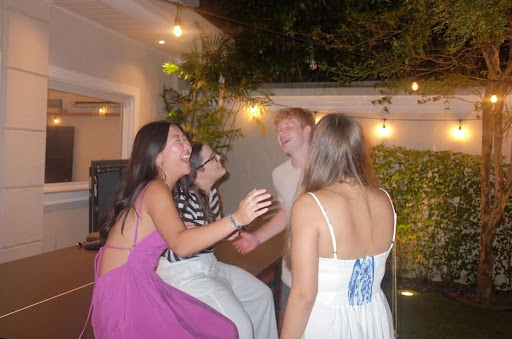Last week, I texted my cousin, who had just flown back to her home. I wanted to write to her: “I wish you were still here, I miss you so much.” But instead of typing all these sentiments, and as I was in a hurry, I sent just two emojis: 😢❤️. She soon replied, “Same here, I wish I was also there.” No need for long confusing sentences, just pure emotions carried with a meaning into two little colorful symbols: 😢❤️.
If you have ever wished to convey an emotion digitally, through WhatsApp or even social media, you’ve probably already used the 👍, 👏,❤️ or 😃emoji. According to BBC News, the most typed word, so far in 2014 was in fact not a word, rather a ❤️emoji. Over the years, these symbols have grown into a cultural phenomenon, used daily by people all over the world, across all ages, and all the time.
The colorful icons that appear in your keyboard, called Emojis, are not simply images, they can represent numerous objects, such as 🍔, 🚗, 👧, 🥼, 🐶 and feelings.
Emojis originated from Japan in the late 1900s, created by Shigetaka Kurita. His initial designs were of 176 simple symbols such as , with the objective of facilitating communication on phones. Over time, they were incorporated into systems like iOS, and soon spread to the rest of the world. They are a cultural phenomenon whose presence has grown over the past few years, changing the way we express ourselves permanently.
Emojis have become known as a new medium for communication in our culture recently. Although they enrich our language, they don’t and won’t ever be able to replace it. Some may argue that words still contain a stronger significance, but in some scenarios, they are not always enough. In many cases, a singular emoji can add another layer of meaning, tone, feeling that a plain text might lack. For example, imagine reading a text from your friend: “I am sad” versus “😭😭😭😭”, it simply doesn’t convey the same effect.
In addition, emojis have removed barriers, making it easier for people with different language to connect 🌍. They also make communication faster and simpler, as the famous saying goes, one image is worth a thousand words.
Recently, I interviewed three students from Graded, the American School of São Paulo, each from a different age group: one lower school student, one middle school student, and one high school student. I asked them questions about how emojis affect communication in their day-to-day lives. They said…
Lower 📚📖🎒✎🏫: Manuela, 6 years old:
When I showed the following emojis: 👧😊🍦, Manuela was easily able to address their meaning and construct a sentence that incorporated the three different symbols ( 👧😊🍦), as she responded: “I am happy because I had ice cream.”
However, when given the words: “the narrator,” “delighted,” and “dessert,” she was unable to unpack their denotation and connotation.
Middle 📚📖🎒✎🏫: Valentin, 13 years old:
Middle school students reflected on how emoji makes easier, more fun and creative. They sometimes play games such as “guess the or through emojis”. Valentin said, “I don’t really use them in school, but I wish we could, because it makes writing more interesting.”
High 📚📖🎒✎🏫: Rafaella, 16 years old:
Rafaella explained that high school students see emojis as a 🌍 language, a type of slang that makes digitally not only quicker but she felt that it is a much easier way of expressing emotions.
Emojis also leave more space for interpretation. A simple ☺️can mean, happy, shy, or awkward, depending on the given circumstances. That flexibility allows people to add and connect to their personality by adding additional layers of meaning, to otherwise “salt” or “pepper” statements. In a futuristic technological, black & white world, where tone is often lost, emojis are able to bring back the color.
People from older generations, such as my grandparents, sometimes argue that emojis can cause miscommunication and misconceptions. What might seem as a 😁symbol in a given country might look rude in another. In Japan, as an example, 🙏means “thank you”, while in the U.S many might read it as “praying”. Minor misinterpretations in the present can lead to great confusion and corruption in the future.
Many adults believe that emojis are quite unprofessional, especially in academic and work settings. Some academic professionals are also starting to worry about the development and growth of these young individuals. As Jennifer Gagner, English teacher at Graded, the American School of São Paulo, said, “More and more students are writing like they are texting. While I believe that emojis are a great tool to communicate their feelings or tell a story in a more concise way, I want students to be aware of how informal expressions might trickle into their formal writing. The use of formal English is essential for academic and professional communication.”
Based on my interviews, it became clear that although emojis may enhance communication, they certainly can’t replace it. I can also conclude that emojis have become more acceptable over time. This is similar to graffiti, what was once seen as vandalism is now seen as art. However, we must proceed with caution because we risk raising a generation fluent in symbols but silent in words.













